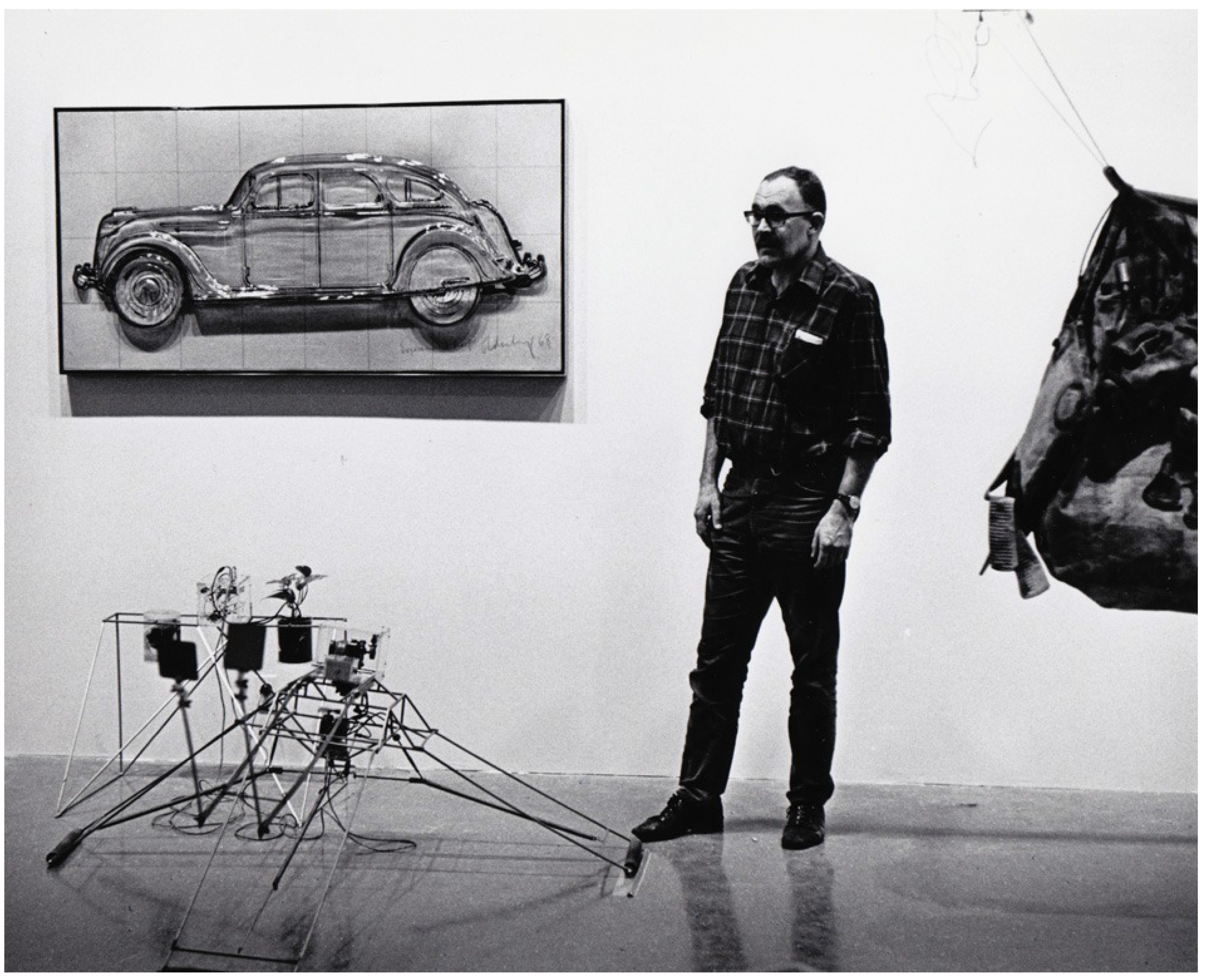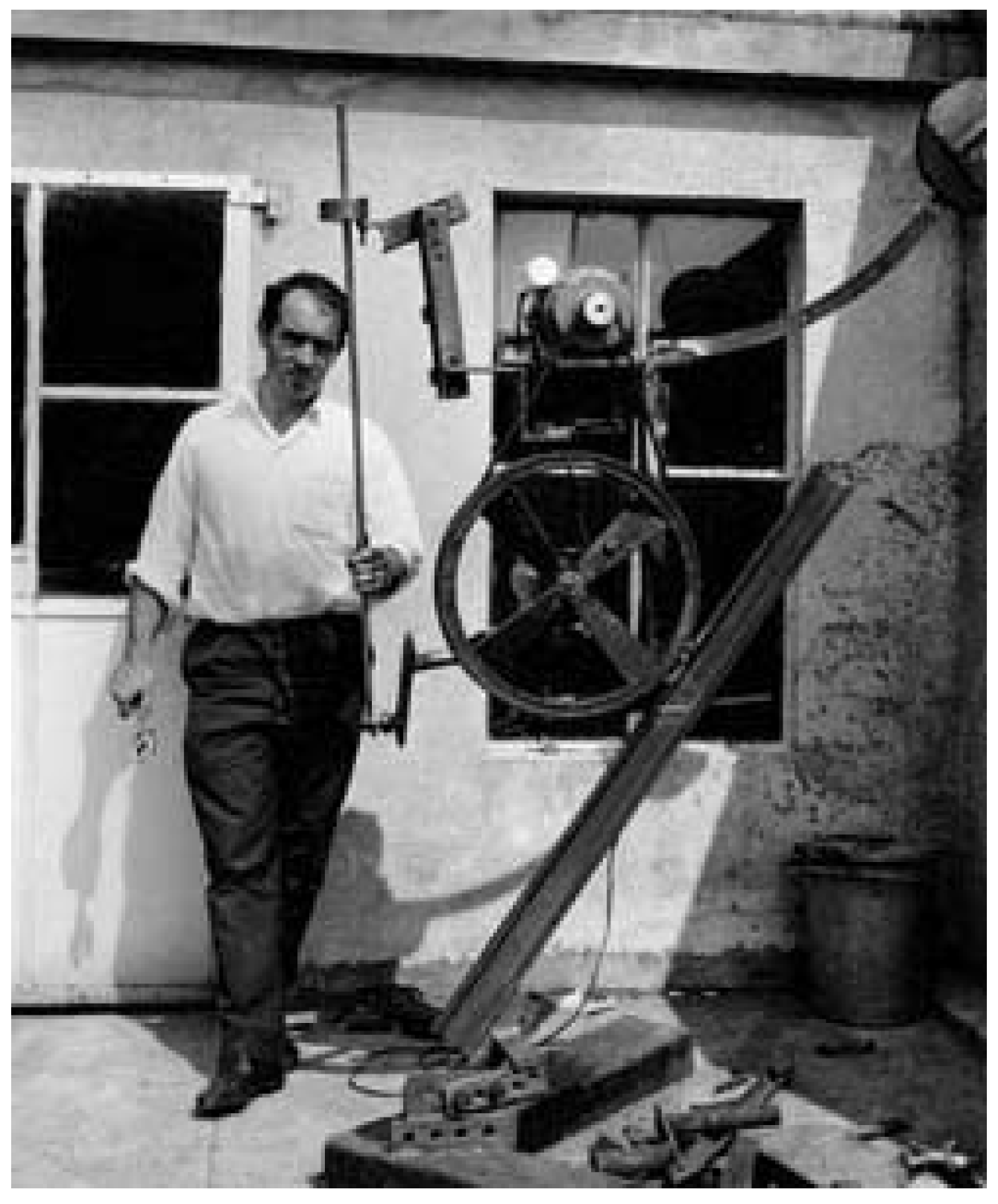The Machine as Art (in the 20th Century): An Introduction †
Abstract
:... reacting more swiftly and intuitively to changes in his immediate environ, and being less hampered by academic specialization and professional commitment, [the artist] has been more attuned to new forms and technological potentials of our period. If Dadaism, Surrealism, Constructivism, and their later variants have sensitized the contemporary vision to the metamorphosis of cultural values, often through a savage and corrosive irony, they have also provided a usable mythology of the machine and an insight into its creative potentialities.
The future of art seems no longer to lie with the creation of enduring masterpieces, but with defining alternative cultural strategies. But in destroying the formal divisions between art forms, and in their casual moves from one expressive medium to another, individual artists do continue to demonstrate new attitudes towards art and life. As art and non art become more interchangeable, ... the artist defines art less through any intrinsic value of the art object than by furnishing new concepts of life style.16
Supplementary Materials
Acknowledgments
Conflicts of Interest
References
- Banham, Reyner. 1967. Theory and Design in the First Machine Age. New York: Praeger, p. 10. First published 1960. [Google Scholar]
- Banham, Reyner. 1954. Match Abandoned. Art News and Review VI: 7. [Google Scholar]
- Banham, Reyner. 1980. Preface to the First Paperback Edition MIT Press. Cambridge: MIT Press, p. 10. [Google Scholar]
- Burnham, Jack. 1968a. Beyond Modern Sculpture: The Effects of Science and Technology on the Sculpture of This Century. New York: George Braziller. [Google Scholar]
- Burnham, Jack. 1968b. Systems Aesthetics. Artforum 7: 30–35. [Google Scholar]
- Burnham, Jack. 1970. Software: Information Technology: Its New Meaning for Art. New York: Jewish Museum. [Google Scholar]
- Burnham, Jack. 1980. Art and Technology: The Panacea That Failed. In The Myths of Information. Edited by Kathleen Woodward. Madison: Coda Press. [Google Scholar]
- Cousseau, Henry-Claude. 2015. Digressions sur les machines: Ingénieurs, bricoleurs et poètes. In L’Art et la Machine. Lyon: Lienart éditions, p. 46. [Google Scholar]
- Griev, Alastair. 1990. Towards an Art of Environment, Exhibitions and Publications by a Group of Avant-Garde Abstract Artists in London 1951–55. The Burlington Magazine 132: 773–81. [Google Scholar]
- Grieve, Alastair. 2005. Constructed Abstract Art in England after the Second World War. A Neglected Avant-Garde. New Haven and London: Yale University Press, p. 27. [Google Scholar]
- Gropius, Walter. 1965. Die Neue Architektur und das Bauhaus (The New Architecture and the Bauhaus). Translated by P. Morton Shand. Cambridge: MIT Press, p. 75. First published 1925. [Google Scholar]
- Hultén, Pontus. 1968. The Machine as Seen at the End of the Mechanical Age. New York: Museum of Modern Art. [Google Scholar]
- Leroi-Gourhan, André. 1983. Le fil du temps. In L’illusion Technologique. Paris: Fayard, p. 127. [Google Scholar]
- McHale, John. 1967. The Plastic Parthenon. Dot Zero 3 Spring: 4. [Google Scholar]
- McHale, John. 1969. The Future of the Future. New York: George Braziller. [Google Scholar]
- McHale, John. 1970. The Ecological Context. New York: George Braziller. [Google Scholar]
- Pardey, Andres. 2013. From Méta-Matic to ‘Métamatic Reloaded’. In Métamatic Reloaded. Heidelberg: Kehrer Verlag, p. 25. [Google Scholar]
- Pierre, Arnauld. 2015. ‘I am the Dream Machine’. Les écrans hypnogènes de Nicolas Schöffer. Les Cahiers du Musée National d’Art Moderne, 53, Winter 2014–2015. [Google Scholar]
- Emanuele Quinz, Jack Burnham, and Hans Haacke, directors. 2015. Préface. Esthétique des Systèmes, Dijon: Les Presses du Réel, 12.
- Reichardt, Jasia. 1968. Cybernetic Serendipity. The Computer and the Arts. London: Studio International, Available online: https://monoskop.org/images/2/25/Reichardt_Jasia_ed_Cybernetic_Serendipidity_The_Computer_and_the_Arts.pdf (accessed on 17 January 2018).
- Alain Rey, director. 1992. Dictionnaire Historique de la Langue Française, Paris: Dictionnaires Le Robert, entry for “Machine”. 2082.
- Wiener, Norbert. 1948. Cybernetics: Or Control and Communication in the Animal and the Machine. Cambridge: MIT Press. [Google Scholar]
| 1 | The technical meaning of the word “machine” is attested from the 16th century. It is then associated with the mechanism, and subsequently with automation. (Rey 1992). |
| 2 | Artist versus Machine. Building Center, Store Street, London, 19 May–9 June 1954. Exhibition organized by Victor Pasmore, Kenneth Martin, Robert Adams and John Weeks. John McHale also presents works. Re this exhibition, see Alastair Grieve’s comprehensive article, (Griev 1990). One might also mention the important Paris exhibition, one year later, dedicated to kinetic art: Le Mouvement, Galerie Denise René, Paris, April 1955. |
| 3 | (Banham 1954), cited in Alastair Grieve, Constructed abstract art in England, op. cit., pp. 29–30. He writes: “… the welcome insistence on the virtue of new materials is sterilized and compromised by an all-too-frequent reliance on Simple-Simon geometrics which the Abstract Art of the twenties inherited from nineteenth century academic theory…”. |
| 4 | (Banham [1960] 1967). He writes: “… we have already entered the Second Machine Age, the age of domestic electronics and synthetic chemistry, and can look back on the First, the age of power from the mains and the reduction of machines to human scale, as a period of the past.” (introduction to the edition of 1967, New York, Praeger, p. 10). |
| 5 | (Hultén 1968), 27 Novermber 1968–9 February 1969, catalog under the direction of Pontus Hultén. (See here for photo of catalog cover: http://www.fondation-langlois.org/html/e/page.php?NumPage=1716). |
| 6 | See here for details on the work Gift for Apollo: https://www.rauschenbergfoundation.org/art/artwork/gift-apollo. |
| 7 | See here for details on the work Dry Cell: https://www.rauschenbergfoundation.org/art/artwork/dry-cell. |
| 8 | Robert Rauschenberg and Billy Klüver also initiated, in 1966, the 9 Evenings: Theatre and Engineering program, supporting the establishment of interdisciplinary projects conciliating art and new technologies. As part of the same approach, one should also mention the Art and Technology Program established by Maurice Tuchman at the Los Angeles County Museum of Art. |
| 9 | (Pardey 2013), 23 October 2013–26 January 2014. |
| 10 | In 1968, both John McHale and Jack Burnham expressed a great deal of interest in the exhibit Cybernetic Serendipity (ICA, London, 2 August–20 October 1968; Corcoran Gallery of Art, Washington D.C., 16 July–31 August 1969; Exploratorium, San Francisco, 1 November–18 December 1969), catalog under the direction of Jasia Reichardt (Reichardt 1968). The discipline itself was formally established in 1948 by Norbert Wiener (Wiener 1948). |
| 11 | (Burnham 1980). Burnham distinguishes between “the earlier ‘machine art’ and what could be defined as ‘systems and information technology’”, and he then goes on to elaborate: “The latter includes artists’ use of computer and online display systems, laser and plasma technology, light and audio-sensor controlled environments, all levels of video technology, color copy duplicating systems, programmed strobe and projected light environments using sophisticated consoles, and artificially controlled ecological sites”. |
| 12 | This artistic transition between the mechanical and the digital (computer art) also generates a geographical dispersion: digital art pioneers such as Frieder Nake, William Latham and Harold Cohen work, respectively, from Stuttgart, London and California. |
| 13 | (Burnham 1970), New York, Jewish Museum, 16 September–8 November 1970; Washington D.C., Smithsonian Institution, 16 December 1970–14 February 1971; catalog under the direction of Jack Burnham. |
| 14 | This same term, “life-style”, is used by Jack Burnham in his text “Art and Technology: The Panacea That Failed” (Burnham 1980, p. 213): “Nevertheless, avant garde art during the past ten years has, in part, rejected inert objects for the ‘living’ presence of artists, and by that I am referring to Conceptual Art, Performance Art, and Video Art. In the case of such artists as Chris Burden, Joseph Beuys, Christian Boltanski, James Lee Byars, and Ben Vautier, art and life activities have become deliberately fused, so that the artist’s output is, in the largest sense, life-style.” |
| 15 | This intellectual world also included at the time some other leading figures as, for example, John Brockman, Gene Youngblood, Douglas Davis, and Billy Klüver. |
| 16 | John McHale, as cited by Pontus Hultén in (Hultén 1968, p. 13). Probably derived, with some slight modifications, from (McHale 1967). |
| 17 | See, in particular, (McHale 1970). |


© 2018 by the author. Licensee MDPI, Basel, Switzerland. This article is an open access article distributed under the terms and conditions of the Creative Commons Attribution (CC BY) license (http://creativecommons.org/licenses/by/4.0/).
Share and Cite
Bessette, J. The Machine as Art (in the 20th Century): An Introduction. Arts 2018, 7, 4. https://doi.org/10.3390/arts7010004
Bessette J. The Machine as Art (in the 20th Century): An Introduction. Arts. 2018; 7(1):4. https://doi.org/10.3390/arts7010004
Chicago/Turabian StyleBessette, Juliette. 2018. "The Machine as Art (in the 20th Century): An Introduction" Arts 7, no. 1: 4. https://doi.org/10.3390/arts7010004




